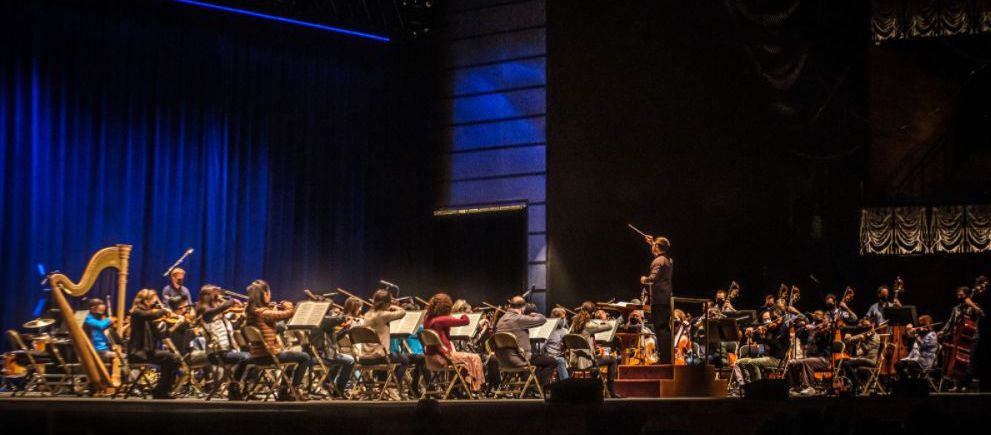With fanfare and a 19th-century composer’s reflection on fate, a boisterous National Symphony Orchestra (NSO) reunited with its casual second home at The Anthem off the Anacostia River on Sunday (October 24, 2021).

The NSO’s concerts at this venue more accustomed to the likes of the Foo Fighters, Lorde, Bob Dylan, and Glass Animals aim to make an otherwise staid institution more accessible to the general public, specifically the younger set. There wasn’t much head-banging or dancing this time, but spirit and spirits alike ran high as twenty- and thirtysomethings sipped on drinks while taking in Carlos Simon’s The Block and Tchaikovsky’s Symphony No. 5. Tickets came in at just $15 to $30 and also included an opening set by the gypsy jazz group Hot Club of Baltimore featuring vocalist Alexis Tantau. Echoes of Edith Piaf’s La Foule faded to cue in the NSO’s musicians, who ditched their concert dress in favor of casual-cool wear more in tune with the industrial-chic locale.

Bassist Jeffrey Weisner was visibly ecstatic as he introduced his colleagues. “It’s been too long and we’re so excited to make live music again,” he said, urging the audience to come see the orchestra in the traditional concert hall just three miles away. “Let me tell you, there’s no way to not look fantastic when you’re wearing your dress tails, so if you want to see us play more stuff in even fancier clothes, live music is back at the Kennedy Center too, so please come.” His pitch for this week’s upcoming program of Ravel’s Daphnis et Chloé and a co-commission by Angélica Negrón of Puerto Rico? It’s “some of the most beautiful, and dare I say sexy, music in the classical repertoire,” Weisner said. The proof will be in how many more seats get snapped up at those performances.

The orchestra then kicked into high gear for an ebullient, albeit brief, study by Carlos Simon, the Kennedy Center’s new composer-in-residence. “Yes, we actually play music by people who are alive,” quipped guest conductor Nicholas Hersh.
The Block (2018) responds musically to an eponymous six-panel work created in 1971 by African American visual artist Romare Bearden (1911–1988). Bearden’s mixed media, cut-paper collage features aspects of Harlem tenement life in and around neighborhood institutions, including a church, a barbershop, and a corner grocery store. Similarly, Simon’s work opens dramatically with timpani, bird-like winds, and shimmering strings that evoke the sun rising over the neighborhood before a swooping chorus of horns like so many cars rushing by on the street and various successive episodes end in a dramatic climax. It’s a dense and multilayered party, much like Bearden’s work.

“You can imagine Harlem in the 1970s as you listen to this piece,” Simon told concertgoers just before the performance. “So I try to build that into the piece, this excitement, this energy, this vibrant nature. You’ll hear it throughout the orchestra; you’ll hear it in the brass—it’s almost like a fanfare—and you’ll hear it in the strings as well as in the woodwinds.” The Atlanta native’s composition was also first on the program for the NSO’s season opener last month.
In terms of taking the listeners on a journey, Tchaikovsky’s penultimate symphony was an especially apt choice, uber-popular as it may be. But where Simon led the audience down a highly evocative path, this time the trip was a more intangible, philosophical one. Composed in 1888 as Tchaikovsky struggled to come to terms with his homosexuality, the symphony is cyclical in nature, opening with a haunting theme on the clarinets that successive orchestra sections take up and transform throughout. The tune described by Tchaikovsky as “a complete resignation before fate, which is the same as the inscrutable predestination of fate,” first presents itself in the funereal, languid tonality of E minor and goes on harmonic travels of its own before ending in a triumphant march in the brilliant key of E major.
Both featured pieces require crisp precision and the acoustics of the cavernous hall designed to accommodate rock concerts with a crowd of up to 6,000 people did not play in the orchestra’s favor. With a 46-foot ceiling height, a 22,875-square-foot main seating area, cement floors, and metal balconies, the flexible-footprint hall is very resonant despite high-tech acoustic treatment and a flexible electroacoustic system. The instruments had to be amplified and some notes lingered a bit longer or sounded hollower than they otherwise would as a result. Things like page turns, which would usually go unnoticed, were more audible. By the same token, the amplification gave added poignancy to moments like the heart-rending horn solo of the second movement. Hersh thanked the musicians silently, clasping a fist to his chest before launching into the third movement and its waltz melody.
Hersh compared Tchaikovsky’s symphonies to Picasso’s self-portraits, noting how both artists’ creative output evolved over time while raising existential questions. “I can’t promise you that you will have the answers to the meaning of life,” Hersh said. Turning to the musicians he was leading for the night, he added: “but if we do our job correctly—no pressure—you may just be ever so slightly closer, just an iota closer. And that, my friends, is why you come to the symphony.”
_____
The NSO returns to The Anthem twice more this season: on December 8, 2021, for its annual holiday concert featuring musicians decked in festive “ugly sweaters” (tickets $15–$30 are available online) and on April 8, 2022, for Prokofiev’s Symphony No. 5 and Esa-Pekka Salonen’s Helix under the baton of Roderick Cox (tickets $15–$30 are available online).
Proof of COVID-19 vaccination is required to attend. More information is here.




